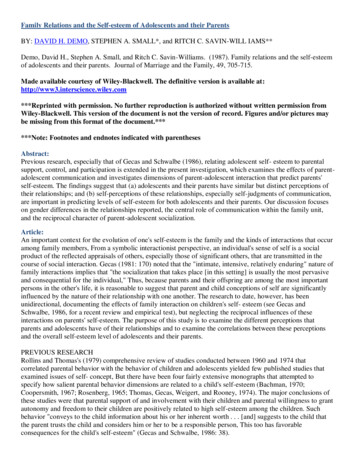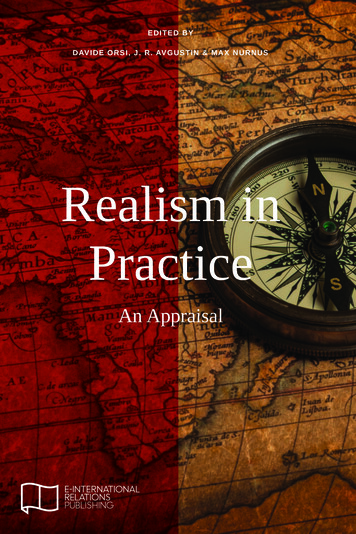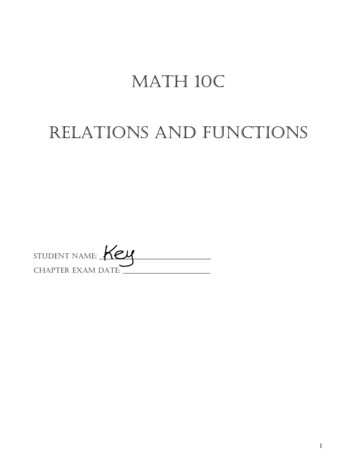
Transcription
Family Relations and the Self-esteem of Adolescents and their ParentsBY: DAVID H. DEMO, STEPHEN A. SMALL*, and RITCH C. SAVIN-WILL IAMS**Demo, David H., Stephen A. Small, and Ritch C. Savin-Williams. (1987). Family relations and the self-esteemof adolescents and their parents. Journal of Marriage and the Family, 49, 705-715.Made available courtesy of Wiley-Blackwell. The definitive version is available at:http://www3.interscience.wiley.com***Reprinted with permission. No further reproduction is authorized without written permission fromWiley-Blackwell. This version of the document is not the version of record. Figures and/or pictures maybe missing from this format of the document.******Note: Footnotes and endnotes indicated with parenthesesAbstract:Previous research, especially that of Gecas and Schwalbe (1986), relating adolescent self- esteem to parentalsupport, control, and participation is extended in the present investigation, which examines the effects of parentadolescent communication and investigates dimensions of parent-adolescent interaction that predict parents'self-esteem. The findings suggest that (a) adolescents and their parents have similar but distinct perceptions oftheir relationships; and (b) self-perceptions of these relationships, especially self-judgments of communication,are important in predicting levels of self-esteem for both adolescents and their parents. Our discussion focuseson gender differences in the relationships reported, the central role of communication within the family unit,and the reciprocal character of parent-adolescent socialization.Article:An important context for the evolution of one's self-esteem is the family and the kinds of interactions that occuramong family members, From a symbolic interactionist perspective, an individual's sense of self is a socialproduct of the reflected appraisals of others, especially those of significant others, that are transmitted in thecourse of social interaction. Gecas (1981: 170) noted that the "intimate, intensive, relatively enduring" nature offamily interactions implies that "the socialization that takes place [in this setting] is usually the most pervasiveand consequential for the individual," Thus, because parents and their offspring are among the most importantpersons in the other's life, it is reasonable to suggest that parent and child conceptions of self are significantlyinfluenced by the nature of their relationship with one another. The research to date, however, has beenunidirectional, documenting the effects of family interaction on children's self- esteem (see Gecas andSchwalbe, 1986, for a recent review and empirical test), but neglecting the reciprocal influences of theseinteractions on parents' self-esteem. The purpose of this study is to examine the different perceptions thatparents and adolescents have of their relationships and to examine the correlations between these perceptionsand the overall self-esteem level of adolescents and their parents.PREVIOUS RESEARCHRollins and Thomas's (1979) comprehensive review of studies conducted between 1960 and 1974 thatcorrelated parental behavior with the behavior of children and adolescents yielded few published studies thatexamined issues of self- concept, But there have been four fairly extensive monographs that attempted tospecify how salient parental behavior dimensions are related to a child's self-esteem (Bachman, 1970;Coopersmith, 1967; Rosenberg, 1965; Thomas, Gecas, Weigert, and Rooney, 1974). The major conclusions ofthese studies were that parental support of and involvement with their children and parental willingness to grantautonomy and freedom to their children are positively related to high self-esteem among the children. Suchbehavior "conveys to the child information about his or her inherent worth . . . [and] suggests to the child thatthe parent trusts the child and considers him or her to be a responsible person, This too has favorableconsequences for the child's self-esteem" (Gecas and Schwalbe, 1986: 38).
Our review of studies published in the decade since the Rollins and Thomas review located additional evidencethat adolescent self-esteem is related to family relationships, although most studies rely on the adolescents'perceptions of these relationships. Variables reported to be significantly correlated with the adolescent's selfesteem include the individual's "feelings toward his or her parents" (O'Donnell, 1976); family conflict andsupport (Cooper, Holman, and Braithwaite, 1983); perceptions of family acceptance, intercommunication, andshared satisfaction (Watkins and Astilla, 1980); and parental support and control, with the latter subdivided intoinduction and coercion (Openshaw, Thomas, and Rollins, 1983, 1984). Gecas and Schwalbe (1986) obtainedsignificant correlations between adolescents' self-esteem and their perceptions of parental support, autonomy /control, and participation, but they found little correspondence between parents' reports of the same behaviorand adolescent self-esteem,There is an emerging consensus among researchers that parental support and participation have a positive effecton an adolescent's self- esteem. The data concerning parental control, however, are less definitive. Theinconsistent findings concerning parental control may be the result of a number of factors, First, although therelationship between parental control and self-esteem may be positive for children, the opposite may be true foradolescents, Baumrind (1971) argued that firm parental control is beneficial for the young child, but a numberof adolescent theorists have emphasized that parents should be fairly permissive with adolescents if the youthare to become autonomous and responsible (Elder, 1962; Hill, 1980). Second, the inconsistent findings may bedue to differences in the sources of information. Coopersmith (1967) obtained data from both mothers andchildren, whereas Thomas et al. (1974) relied entirely on data reported by adolescents. Gecas and Schwalbe(1986) compared adolescents' reports of parental control/autonomy with those of both parents and obtainedcorrelations ranging from .24 to ,41. A symbolic interactionist perspective suggests that it is necessary toexamine the adolescent's perceptions as well as the parents' perceptions of control in family relations, From theadolescent's perspective, control involves the parent's attempt to limit or direct his or her activities (Gecas andSchwalbe, 1986); thus, the more the adolescent feels that decisions and behaviors that affect him or her areunder the control of the parent, the lower will be his or her level of self-esteem. Parents may view their controldifferently, however, perceiving it as necessary for the adolescent's growth and development.In addition to support, control, and participation, another mediating variable, parent-adolescent communication,is suggested by Olson's Circumplex Model of Marital and Family Systems (Barnes and Olson, 1985; Olson,McCubbin, Barnes, Larsen, Muxen, and Wilson, 1983), According to this model, open and frequent communication is critical in that it enables supportive-affectional feelings and behaviors to be transmitted betweenfamily members. Although there is strong support for the central role that communication plays in familyfunctioning, prior researchers have generally neglected to examine this dimension when studying parent-childrelations or familial antecedents of individual wellbeing and development.Finally, we examine a second dimension of support, namely, the support adolescents give their parents. Just ascommunication is, by definition, a reciprocal process, the support that is exchanged in family relationships isbidirectional (parent to adolescent and adolescent to parent) and can be conceptualized as part of a reciprocalsocialization process. Because adolescents assign considerable importance to their role identity as son ordaughter (Hoelter, 1986), it is reasonable to expect that those adolescents who feel good about theirrelationships with their parents, demonstrated by supporting and expressing affection totheir parents, will experience higher self-esteem. Viewed in this manner, adolescents' support of parentsprovides an additional indicator of the quality of parent-adolescent relationships.FAMILY INFLUENCES ON PARENTS' SELF-ESTEEMNo study of which we are aware has examined the possibility that children influence parents' self-evaluations. Arecent indication of the pervading unidirectional emphasis is that Gecas and Schwalbe (1986: 37) opened theirpaper by stating, "The family is generally considered an important context for the development of a child's selfconcept" (emphasis added), but they did not make the same assertion in regard to the parent's self-concept.Their important contribution to the existing literature was to add a comparison of the influence of parent reports
and child reports of parental behavior on the child's self-esteem. We agree that this is an essential addition, butwe carry the logic one step further by assessing how the parent's self-esteem is related to parent and childreports of their behavior toward one another.Despite Bell's (1968) early warning on the direction of effects in socialization studies, the reciprocal nature ofparent-child interaction is often overlooked by researchers whose focus on adolescent self-esteem implies anassumption that processes of socialization and self-concept formation have crystallized by late adolescence,thereby neglecting the role that children play in shaping the lives of their parents. This empirical omission is notconsistent with sociological theories (e.g., reflected appraisals) nor with life course perspectives (e.g., humanecology, life span development), both of which acknowledge and emphasize the importance of viewing mutualadult-child influences on developmental processes. Indeed, there are repeated occasions in which parents judgechildren and children judge parents regarding each other's worth, competence, and effectiveness as individuals.Viewed in this way, the family is a critical context for self- concept formation in that by adolescence thechildren come to see some part of themselves as they perceive their parents view them, and conversely, parentscome to see aspects of themselves as they perceive their adolescent children view them.For these reasons we examine the correlations between parents' self-esteem and the same dimensions of parentadolescent interaction that we propose influence adolescent self-esteem: support given and received in therelationship, communication, and participation in joint activities. In addition, because parents often experienceconsiderable stress in managing the responsibilities associated with teenage children (Kidwell, Fischer,Dunham, and Baranowski, 1983), we examine the relationship between the level of stress parents report in thisrole and parents' overall feelings of self-esteem.ANALYSES AND EXPECTATIONSIn examining self-esteem, we rely on Rosenberg's (1979: 54) definition: A person who possesses high selfesteem "has self-respect, considers himself a person of worth." The term low self-esteem "means that theindividual lacks respect for himself, considers himself unworthy, inadequate, or otherwise seriously deficient asa person." Our measures of family relationships include both parents' and adolescents' perceptions of theirrelationship, allowing comparisons of these perceptions as well as comparisons of one's own perceptions versusothers' perceptions with one's self-esteem. The symbolic interactionist argument (Blumer, 1969; Gecas, 1971;Gecas and Schwalbe, 1986; Peterson and Rollins, 1986) is that an individual's perception or interpretation ofothers' behavior is more important to that individual and his or her self-esteem than is others' actual behavior.We therefore expect a stronger relationship between the adolescent's perceptions of parental behavior and theadolescent's self- esteem than between the parent's perceptions of parental behavior and the adolescent's selfesteem. Conversely, we expect a stronger relationship between the parent's perceptions of her or his behaviorand parent's self-esteem than between the adolescent's perceptions of the relationship and parent's self-esteem.Given existing theory and the empirical literature reviewed above, we suggest that both parent and adolescentself-esteem will be related to perceptions of intrafamilial support, participation, and communication.Specifically, the higher the reported level of support, participation, and communication, the higher will be theself-esteem of adolescents and their parents. Although, as previously noted, we expect to find a relationshipbetween adolescents' perceptions of parental control and adolescent self-esteem, there is little plausible reasonto believe that parental control will be related to parents' self-esteem. Finally, we expect to find a negativerelationship between parental self-esteem and the level of stress parents experience in relationships with theiradolescents.METHODParticipantsThe sample consisted of 139 parent-adolescent dyads.(1) Parents were enrolled in one of five one- week familyoriented summer educational sessions sponsored by Cornell University. Families with adolescents between theages of 10 and 17 years were invited to participate in the study at an orientation meeting.
The participants were predominantly white, middle or upper-middle class, and highly educated; 90% of thefathers and 82% of the mothers graduated from college. All of the parents were married at the time; 60% of theparents were female and 40% were male. Fathers ranged in age from 33 to 61 years (mean 43.2); mothersfrom 32 to 53 years (mean 41.2). One parent from each participating family was included in the study, Theparticipating youth, 70 females and 69 males, ranged in age from 10 to 17 years, with a mean of 13.4 years.(2)ProceduresParents were instructed to complete questionnaires by themselves without discussing them with their spouse oradolescent child. The first questionnaire assessed aspects of their relationship with their child, and the secondinstrument measured the parent's self-esteem. They were informed that all responses would be kept strictlyconfidential. Later in the week, adolescents were administered questionnaires that included a self-esteeminstrument and measures of the parent-child relationship. Adolescents were given assurances similar to thosegiven their parents concerning the anonymity of their responses. Instructions for completing the questionnairewere given orally and all questions concerning the purpose or procedures of the study were answered. It shouldbe noted that parents and adolescents were housed in separate residences and there was little contact betweenthem during the week-long session.MeasuresThe complete questionnaire, the items that comprise each scale, their item-total correlations, the method used toscore the scale, and the scale's alpha reliability coefficient are presented in detail in Small (1985). All measureswere pretested in a pilot study with adolescents and their parents. Those items in a measure that did notcorrelate significantly (p .01) with the scale's total adjusted score (the sum of all the items in the scale minusthat specific term) were excluded from the final measure. The components of the question naire for parents andfor adolescents are described below, with alpha reliability coefficients shown parentheses.Parent Questionnaire1. Parent's expression of support to the adolescent (.89). This measure assesses how frequently the parentexpresses affection to the adolescent. It is composed of seven items that ask the parent to indicate the frequencywith which he or she exhibits to the adolescent a number of affectionate verbal and nonverbal behaviors, suchas hugging and kissing. Response categories range from "a few times a day" to "never."2. Parent's perception of the adolescent's support (.85). The parent's report of the adolescent's affection andpositive sentiment for the parent was assessed by the 6-item support scale from the Child Behavior Toward theParent Inventory (Schaefer, Edgerton, and Finkelstein, 1979). The parent was asked questions such as whetheror not the adolescent seems eager to do things with him or her. There are four response categories ranging from"very much" to "not at all."3. Parental control over decisions involving the adolescent (.88), This measure was developed to assess thepattern of decision-making between parent and adolescent. The Independence Training Index, employed byElder (1962) and Kandel and Lessor (1972), is composed of a single item that asks the respondent how mostdecisions are made in his or her family. There are five response categories along a continuum from highparental domination to high parental permissiveness. A new measure was developed, resembling the original inits basic format but differing in that it asks the respondent how decisions are made on a wide variety (15 items)of issues.4. Parental stress (.89). Parental well-being was assessed by a subjective measure of stress. Following Pearlinand Schooler (1978), the present investigation relies on the self-reported experience of emotional stress. Thenine-item scale asks the parents how bothered, content; or emotionally upset they felt when they thought abouttheir present experience as parent of the target adolescent. There are four response categories ranging from"very" to "not at all."
5. Parent's perception of parent-adolescent communication (.84). The parent's perception of the level ofpositive communication between parent and adolescent was assessed by a four-item scale developed for thepresent investigation. The items ask the parent how frequently he or she has friendly discussions with his or herchild about both positive and negative concerns or topics (e.g., "How often do you have friendly conversationswith your child?"). The six response categories range from "never" to "a few times a day."Adolescent Questionnaire1. Adolescent's expression of support to the parent (.83). Parallel to the support measure administered to theparent, this scale assesses how frequently the adolescent expresses affection to the parent, The measure iscomposed of seven items that ask the adolescent to indicate how frequently he or she exhibits a variety ofaffectionate behaviors to the parent.2. Adolescent's report of parent's support (.72). The parent's warmth, support, and positive sentiment for theadolescent was assessed by the Maternal and Paternal Support Scales from the Cornell Parent BehaviorInventory (Siegelman, 1965), Each scale is composed of six items.3. Adolescent's perception of parental control (.75). How restrictive and controlling the child perceives theparent as being was ascertained by the Maternal and Paternal Control-Autonomy Scales from Schaefer's (1965)Child Report of Parent Behavior Inventory. Each scale contains four items.4. Adolescent's participation with parents (.68). A six-item scale was developed to assess the amount of timethe adolescent spends with his or her parent in educational and recreational activities, such as watchingtelevision, playing games, and attending movies or events. The six response categories range from "a few timesa day" to "never."5. Child's perception of parent-adolescent communication (.84), Parallel to the communication measureadministered to parents, the level of positive communication between adolescent and parent was assessed by afour-item scale developed for the present investigation. The items ask the adolescent how frequently he or shehas friendly discussions with the parent about his or her concerns, worries, interests, and recent experiences(e.g., "How often do you talk to your mother/ father about your worries or problems?"). The six responsecategories range from "never" to "a few times a day."Self-EsteemFor both parents and adolescents, self-esteem was assessed by the Rosenberg Self-Esteem Scale (RSE), a seriesof 10 questions concerning feelings about self-worth (e.g,, "I take a positive attitude toward myself"). Fourresponses are possible, ranging from "strongly agree" to "strongly disagree." In the present study the overallalpha reliability coefficient for the RSE was .86, corn- parable to other reports on the reproducibility of RSE(Demo, 1985).AnalysesOur analyses involve examining the relationship between aspects of parent-adolescent interaction andadolescent and parent self-esteem. We begin by examining the simple relationship between adolescent andparent reports of dimensions of the parent-adolescent relationship. Then, because existing research and theorysuggest important differences in parent-adolescent interaction based on the parent's and adolescent's gender(e.g., Gecas and Schwalbe, 1986; Maccoby, 1980; Maccoby and Jacklin, 1974), we present separate correlationsand regression coefficients to predict the self-esteem of sons, daughters, fathers, and mothers.RESULTSIntercorrelations of MeasuresThe means, standard deviations, and Intercorrelations for all of the measures are presented in Table 1. In Table2 we focus attention on the congruence between adolescents' perceptions and parents' perceptions of fourdimensions of the parent-adolescent relationship: parents' support of adolescents, adolescents' support of
parents, parental control, and communication. Eleven of the 16 correlations are significant, with most in the .30sand .40s, No correlation exceeds .55, indicating moderate levels of convergent validity between parents' reportsand adolescents' reports of the same behavior. This pattern is consistent with the findings obtained by Gecas andSchwalbe (1986), although the correlations presented here are slightly stronger.Our data also indicate greater congruence between mothers' and adolescents' reports (seven of eight correlationsare significant at the .01 level) than between fathers' and adolescents' reports. The strongest correlation isbetween mothers' and sons' reports of adolescents' support of parents (r .55), and the only nonsignificantcorrelation coefficient for mothers' and adolescents' reports is for perceptions of parental control over sons'activities.Sons' reports of parental control do not correspond with fathers' reports either. In fact, all of the correlationcoefficients for fathers' and adolescents' reports are smaller than the corresponding coefficients for mothers andadolescents; only four comparisons between fathers' reports and those of their children are significant, Reportsof parent-adolescent communication are the only reports in which there is significant correspondence across allfour dyads.
Correlates of Adolescent Self-esteemThe pattern of correlations shown in Table 3 clearly indicates that the self-esteem of adolescents is morestrongly correlated with their own perceptions than with parents' perceptions of the parent-adolescentrelationship. Only one parent- reported variable, communication, is significantly correlated with adolescent selfesteem. But among adolescent-reported indicators of the relationship, only one (parental support) is notsignificantly related to adolescent self-esteem.(3) Although parental support is unrelated, adolescents' support ofparents is significantly related. The variables most strongly correlated with adolescent self-esteem arecommunication and participation; parental control is inversely related.The data also indicate that sons' self-esteem, compared to daughters', is more strongly correlated withdimensions of the parent-adolescent relationship. The strongest correlations in Table 3 pertain to sons' selfesteem and their perceptions of communication with parents (.44) and participation in joint activities (.41). Ofthe variables reported by sons, only parental support is unrelated to their self-esteem. Examining correlates ofdaughters' self-esteem, all five daughter-reported indicators of the relationship exhibit modest associations. Forsons' and daughters' self- esteem, parental perceptions of the relationship are unrelated.Regression Analysis: Adolescent Self-EsteemGiven the correlational findings and the general consensus of existing research and theory, we regressedadolescent self-esteem on parents' and adolescents' perceptions of support and control. Two other variables,participation and adolescents' support of parents, are highly correlated with parental support of adolescents andthus appear to be assessing the same general support dimension; for these reasons the former two variables areexcluded from the regression equation (similar to Gecas and Schwalbe, 1986). We also include gender in thetwo regression equations used to predict the self-esteem of all adolescents (Table 4). Model 1 thus includes fivepredictor variables frequently used in previous research. Model 2 includes these same predictors, but we addreports of parent-adolescent communication. This enables us to assess the amount of additional varianceexplained by these two variables and to determine if the effects of variables included in Model 1 are differentwhen their effects are partialled out by the inclusion of communication variables in Model 2.The data indicate that boys (x̄ 33.52, SD 10.42) have slightly, but not significantly, higher self-esteem thangirls (x̄ 31.91, SD 11.03). In the regression predicting the self- esteem of all adolescents (Table 4, Model 1),only parental control exerts a significant influence, and its effects are negative in direction. But in Model 2 thedirect effects of parental control become nonsignificant and the only significant predictor is adolescents' reportsof communication, contributing to a substantially larger R2 (.161) than in Model 1 (.043). The same patternholds when boys and girls are examined separately: when perceptions of communication are included in the
regression, none of the variables in Model 1 have significant effects. Adding reports of communication explainsan additional 20% of the variation in boys' self-esteem and an additional 5% of the variation in girls' selfesteem. It is also evident that boys' self-esteem, compared to that of girls, is more strongly influenced by parentadolescent interaction, corroborating the findings of Gecas and Schwalbe (1986).Correlates of Parental Self-EsteemExtending prior investigations by examining the reciprocal influences of parent-adolescent relationships on theself-esteem of parents, Table 5 reveals again that one's own perception of these relationships is related to selfesteem, while others' perceptions show relatively little relationship. Parents' self-esteem is higher if theyperceive that they receive support from, and can communicate with, their adolescent children. Parental reportsof stress in raising their sons and daughters is adversely related to parents' self-esteem, although this effect isnot significant among fathers. Parent-adolescent communication, on the other hand, is significantly correlatedwith fathers' self-esteem but not with that of mothers. In sum, the correlational data provide some indication ofreciprocal socialization influences in parent-adolescent relationships.Regression Analysis: Parental Self-esteemNext, we regressed parental self-esteem on gender and reports of adolescent support of parents, parental stress,and parent-adolescent communication. Parents' support of adolescents was not included in the analysis becauseof its high intercorrelations with adolescents' support of parents. The data presented in Table 6 confirm theearlier findings indicating that self-perceptions of parent-adolescent relations are related to self-esteem, whileothers' perceptions are consistently unrelated. Further, there is no gender difference in parents' self-esteem.In Model 1 parental judgments of support received from adolescents are positively related, and parental stress isnegatively related, to parents' self-esteem. But when reports of communication are included in Model 2, thedirect effects of support from adolescents become nonsignificant and communication exerts a significantpositive effect. In addition, the amount of explained variation in parents' self-esteem is doubled (to 17%) by including reports of communication. Consistent
with the correlational findings, self-reports of communication are significantly related to the self-esteem offathers but not mothers, Further, parental stress is again inversely related to mothers' self-esteem but unrelatedto that of fathers.DISCUSSIONOur data provide empirical support for two central propositions: (a) adolescents and their parents haveindependent yet overlapping perceptions of their relationships; and (b) the individual's perceptions of therelationship are consistently related to his or her self-esteem while the others' perceptions are generallyunrelated. Viewed from a symbolic interactionist perspective, these findings suggest that the intimate,challenging, and emotionally charged nature of parent-adolescent relations is indeed influential in shaping theself-concepts of all family members involved. We believe the nature of these relationships is critical in that bothadolescents and parents serve as significant others whose opinions and reflected appraisals are influential inshaping the others' self-esteem. Reflected appraisals are mutually transmitted as parents and their childreninteract in daily social encounters.In general, the reports of adolescents on family relations were more congruent with the reports of mothers thanof fathers, highlighting the central role of the mother in interpersonal family relations. Our findings also indicatethat the self- esteem of boys, compared to that of girls, is more strongly related to family relations, replicatingthe findings of Gecas and Schwalbe (1986). They propose that one reason for "the stronger relationship betweenparental behavior and boys' self-esteem (compared to that for girls) is . greater parental responsiveness to thes
In examining self-esteem, we rely on Rosenberg's (1979: 54) definition: A person who possesses high self-esteem "has self-respect, considers himself a person of worth." The term low self-esteem "means that the individual lacks respect for himself, considers himself unworthy, i










